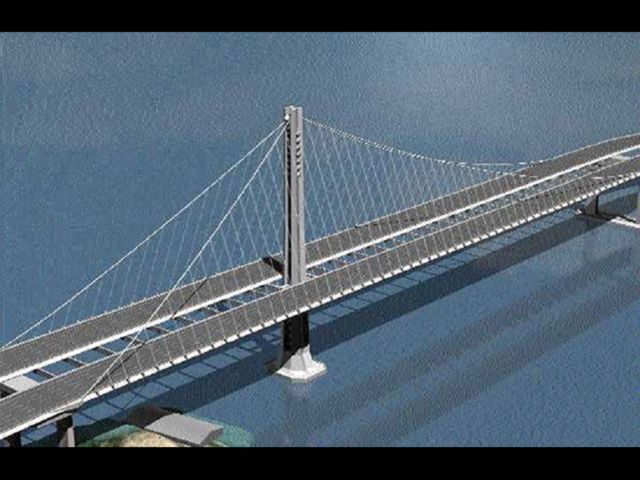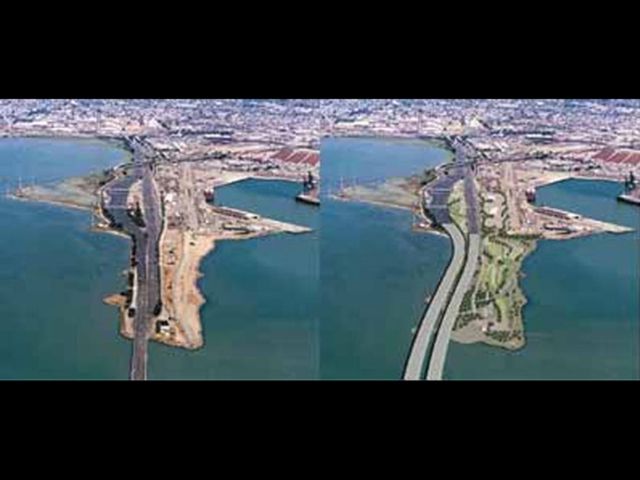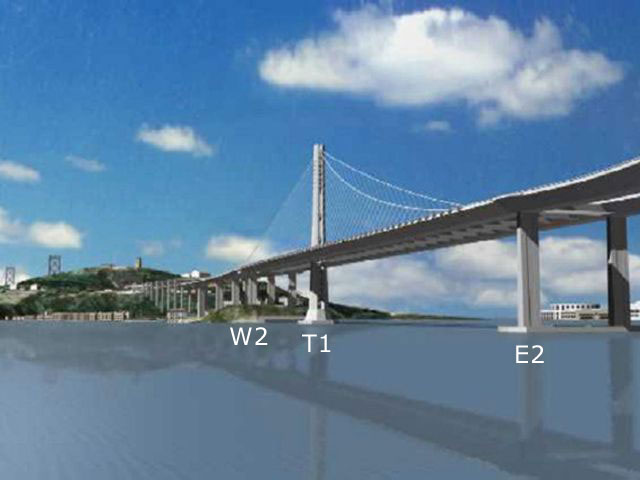|
$5.8 bil. for the Bay Bridge &
still pushing a $3 billion Transbay Terminal ?
($3 billion, SO FAR ! )
|
The
East
Side
of the Bay
Bridge is actually
2 bridges -- nearly two
miles of Twin concrete
Viaducts reaching west from Oakland and the
Replacement of the
East Span, a
single-tower suspension span
connecting to Yerba Buena Island. Both now
totalling $4.4 billion (from $2.6 bil. in 2001),
http://www.donaldmacdonaldarchitects.com/SFOBB/SFOBB_east1.html
"The cost-benefit ratio of the Transbay Terminal is really absurd,"
said Bill Blackwell, a retired
Bechtel architect,
who contends that the new terminal costs
aren't justified by the improvements for transit riders. "People seem to
think we need a new monument,"
Blackwell said. "We don't need a
fancy new terminal. It doesn't do anything to enhance transit use."
For that kind of money we should be
doing SOMETHING that will
actually relieve Traffic Congestion.
Instead of spending $3 billion (prob $7 bil.) on a
cost-ineffective
Transbay Terminal,
( A statewide
high-speed rail
bond set for the November 2004 election, would contribute $127 million. )
lets spend it on something that will
directly
reduce CONGESTION
and air-pollution
- the
19th
Ave Tunnel bypass
|
 |
|
Caltrans, said
the estimated COST
of retrofitting or replacing
7 state
toll bridges,
including five in the Bay Area, climbed from:-
$2.6
billion in 1997
to $4.7
billion in 2001 (although
SF. Chron says 5.1 )
to $7.4
billion Aug
2004 (not
including a $900 million contingency for future overruns)
The bulk of those increases
from $4.7 to $7.4 bil.--
(all but
$286 million and $700
mil. on the western
span) -- were on the new
Eastern
Span
of the
Bay Bridge
and
53% of that on
the selection of the
single-tower
suspension bridge,
unusual
features and
orthrotropic steel boxes,
totalling $4.4
bil for the
East
Side alone.
The remainder of the
East
Side overruns
(47%)
are attributable to increases in the costs of steel,
cement, bonding and insurance, and consolidation in the bridge
construction industry.
The cost for the East
Span
was estimated at
$1.3 billion
before 2001 to
$2.6
in 2001 to
$4.4 bil.
2004, ($1.4 bil. for the
west side
and $1.6 bil. for the
6 other bridges).
Caltrans acknowledged that the cost had risen because of
bad estimates
and
design-caused delays. |
The 2004,
$7.4
billion
COST
estimate
to retrofit
seven state-owned
toll
Bridges
including fixing
the
east
& west side
of the San Francisco-Oakland Bay Bridge
is:-
2004
mils. $ |
Bridge
(data fixed from SF Chron.) |
2001
mils. $ |
$4,400
not 5,130
|
East Side
of the San Francisco-Oakland
Bay Bridge |
was $1,300 mil. before, then $2,600 mil
|
$1,400
not $737
|
West Side
of the San Francisco-Oakland Bay Bridge
retrofit, as a lifeline bridge |
was $700 mil then $737 mil. |
|
$180 |
Benicia-Martinez Bridge retrofit |
$190 |
|
$115 |
north span of the Carquinez retrofit
|
$125 |
|
$914 |
Richmond-San Rafael Bridge retrofit
|
$665 |
|
$165 |
San Mateo-Hayward Bridge retrofit
|
$190 |
| $62 |
San Pedro-Terminal Island Bridge retrofit |
$62 |
| $105 |
San Diego-Coronado Bridge retrofit |
$105 |
| 7,400 |
TOTAL |
4,674 |
|
| Gov. Arnold
Schwarzenegger: "It is Bay Area taxpayers sole responsibility
for meeting an estimated $2.3 billion in cost overruns to complete the Bay
Bridge project":
Appoint an independent auditor to find out why it has taken 15 years
to complete the seismic retrofit, which includes constructing a new
eastern span. (2 years solely attributable
to Willie Brown)
Nov. 2 ballot could ask Bay Area voters to
redirect
the
existing $1
Toll Increase
to cover
the bridge overruns (
OR the
Metripolitan Transportation Commission (MTC) could divert already
allotted state funds for other projects to the bridge )
Transfer responsibility for the retrofit project to the Metropolitan
Transportation Commission, MTC.
Caltrans expected
bids from two joint ventures
and possibly a third. “I’m
surprised we only got one bid,”
adds the Metropolitan Transportation
Commission, “I do not know why the
contractors were on the sidelines on this project.”
Sources close to the bidding say a joint venture of Peter Kiewit Sons’
Inc., Omaha, and Skanska Inc., Whitestone, N.Y., was another contender as
late as one month before the bid opening, but it did not ultimately bid.
“We were interested,” says Bruce Grewcock, Peter Kiewit chief operating
officer.
Kiewit itself was the sole bidder for an earlier bridge foundation
contract last year, which came in 63% over estimate (ENR 11/3/03 p. 10).
The firm had won the
job in a rebid, with too low a figure.
Bidding executives point to the gyrating steel market for a structure
whose unique design and construction specs could require as much as 100
million lb of permanent steel and another 40 million lb of temporary steel
falsework, says Cagelis. “Individual pieces get very large,” he notes.
“You have to do it perfect the first time.”
Other reasons: Seismic requirements and location across a fault line,
tight tolerances, tough quality demands.
Because the self-anchored
suspension
span is
specified by state
legislation authorizing the bridge, legislative
approval would be required if Caltrans switched bridge types.
“The best way to complete the bridge
is to stick with the bridge type and get to a point where you’re ready to
go,” McElhinney says. “Any additional time added to the schedule is cost
added to the structure.” Some speculate that
significant redesign could add
up to four years to completion. |

Twin concrete Viaducts |
 |
|
This could be an ideal
opportunity to
cut 80% from the spending of the $1 Toll
Increase,
cut
projects that will make relatively no difference
to
Traffic Congestion.
With little change to Traffic Congestion
80% of the $'s, from the existing, new $1 bridge toll
increase, could be
re-directed towards the bridge
with little effect on congestion. (Of course we
still don't want the State to renege from paying their half too,
Arnold):-
$787
on
RAIL including:
$150 downtown Caltrain extension in San
Francisco
$143 BART Transbay Tube seismic strengthening
$135 Commuter rail service over Dumbarton
rail bridge
$96 BART extension from Pittsburg/Baypoint
station east to Byron
$95 BART extension to Warm Springs
$35 "SMART" Rail Marin
$107 FERRY
$168 Other Transit
Contact your representatives click on "Find my District"
|
the 20% Spending from the
$1 Bridge Toll that
DOES
Reduce Congestion Cost Effectively:-
$65 I-580 rapid bus corridor improvements in
Dublin, Pleasanton, Livermore
Interchange improvement at U.S. 101 and Larkspur
ferry
$35 Greenbrae Interchange
$100 I-680/I-80/Highway 12 interchange
improvements in Solano County incl some of the following:
$50 Benicia-Martinez Bridge: New Span
$50 Interstate-80: Eastbound High-Occupancy
Vehicle (HOV) Lane Extension from Route 4 to Carquinez Bridge
$50 Caldecott Tunnel Improvements. Provide funds
to plan and construct a fourth bore
$20 Solano County Express Bus. Curtola Park and
Ride, Benicia Intermodal Facility, Fairfield Transportation Center
and Vacaville Intermodal Station
$65 AC connection to BART. Enhanced Bus-Phase 1
(International Blvd./Telegraph corridors)
$22 Express Bus Service for San Mateo, Dumbarton,
and Bay Bridge
Regional Express Bus - Richmond-San Rafael
Bridge, Carquinez, Benicia-Martinez and Antioch Bridge corridors.
|
|
The Business, Transportation and
Housing Agency,
http://www.bth.ca.gov oversees CALTRANS. |
State law
prohibits Caltrans from accepting bids when it doesn't have the money
on hand to cover the full cost. Even if the voters approve paying for
it out of the new, existing $1 bridge toll in November election,
Caltrans would not have
the money when the bid for the
sleek new design
expires in September,
(expiration
of the lone bid for the
single-tower suspension section
of the new bridge). |
A joint venture of American Bridge,
http://www.americanbridge.net/locations/cory.php
Nippon Steel Bridge
and Fluor Corp. submitted a bid for
the Western
Side Retrofit in May 2004 of $1.8
billion using
domestic steel -- ($1.4
billion
if foreign steel is allowed).
The bid far exceeded
Caltrans' estimate of $740 million.
because of the unique design, tough schedule, strict specifications and likely
flaws in developing and communicating the engineer’s estimate. Caltrans also
extended the construction schedule by 15 months.
As Caltrans evaluates a $1.4 billion bid for the Western Retrofit, the
bidder is arguing against looking at any other bids. Another bid would delay
the project and boost costs, perhaps by hundreds of millions of dollars, the
lone bidder says.
A new bidding process will delay the project a year beyond the estimated 2010
ribbon cutting. U.S. trade regulations could add hundreds of millions of
dollars to the project cost. Federal rules require the use of domestic steel,
unless the price tag is 25 percent less with foreign steel - so the lower bid
(1.4) will prevail in this case. However, if the bidding reopens, current
foreign steel prices would allow domestic suppliers to beat the foreign steel
bid. (Caltrans
has reopened bids in the past and received lower
domestic
cost estimates,
still higher than foreign but now within the 25%).
SF Chron Article
http://www.sfgate.com/cgi-bin/article.cgi?file=/c/a/2004/08/17/MNGPB89CQ01.DTL
|
